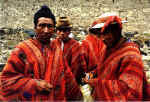
Photo: Alejandro Balaguer
"Listen pal, no one had even
heard of the Inca Trail until
we discovered it on
May 1st, 1960. Yes sir,
we got to Machu Picchu
two-and-a-half days later and
we were welcomed as heroes."
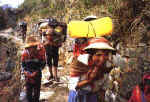
Photo: Alejandro Balaguer
Huayruro Porters on their
way down from the heights.
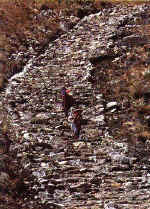
Photo: Alejandro Balaguer
Impressive stairway going
down the Warmiwańusca pass.
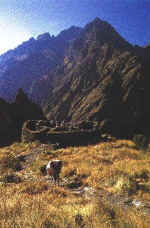
Photo: Alejandro
Balaguer
The Runacuracay ruins
dominate the abyss.
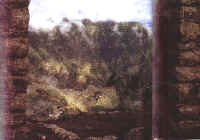
Photo: Alejandro Balaguer
Machu Picchu
|
Headed for Huayllabamba, with This
remark Alfredo Sanchez, our 66-year-old guide, leads us off along the Urubamba
River past Chilca, on our first day on the Inca Trail. "Nobody
knew the way. We walked towards the Kusichaca River just like we're doing now, and then we
climbed the gorge up to Huayllabamba" he continues. "From here onwards, nobody
was quite too sure of what exactly lay ahead. In fact, we even wandered knew anything. The
local people didn't even know what Machu Picchu was."
Don Alfredo rambles on about his discovery. I settle for
taking photos of the geometrically-shaped potato fields that lie in the Urubamba Valley,
which the ancient inhabitants of the Sacred Valley used to call the Vilcanota.
After a three-and-a-half hour walk, just before reaching the
Llactapata ruins, we are met by a dozen grinning characters loaded with back-packs, pots
and tents, who from now on will be our cooks and porters during the exhausting five-day
trip. We stop. We are now overlooking Llactapata, the military check-point for all
pilgrims headed for Machu Picchu. Its defense walls are perfectly outlined down below as
we gradually lose sight of the Urubamba Valley. Towards dusk, we get the first glimpse of
our campsite in Huayllabamba, Manco Inca It's last refuge from the hordes of invading
Spaniards.
At night, under the bejeweled Andean sky, Don
Alfredo recalls the misfortunes of an Irishwoman during the climb up to Warmiwańusca,
about13,000 feet sea level, the highest pass on the Inca Trail. She was so shattered, Don
Alfredo slung her over his shoulder and carried her for hours. The woman was so
grateful, she wanted to marry him!
Day Two
Daybreak. Huayllabamaba fades away as we enter a forest of
quenoas, bright orange tree that is only to found on the Andean heights. Here the
trees are festooned with an epiphytic plant called salvajino, looking rather like beards
against the bare bark. The quenoas of Llulluchayoc lend the spot a mystical
air. We continue to climb, leaving behind ichu grass pastures and a long line
of exhausted-looking hikers. At the top of the pass you feel like you're on the top of the
world. Far below lie the depths of the Sacred Valley, while ahead lie a chain of bright
green valleys known as the Valley of Silence. The faces of the trekkers who arrive one by
one glow with the feeling of having achieved a glorious goal, a felling I share with them.
Just then, a row of athletic porters jog past us, taking us down a notch or two. An Inca
staircase which is as wide as a street takes us hundreds of meters down to
Pacaymayo.
Day Three
It is mid-morning and we are walking on an
Inca granite carpet spread over the lush rainforests of the Valley of Silence. I am still
dazed by the mages of yesterday's sunset in Pacaymayo: a sunbeam piercing the opening
clouds after a light rain over the snow clad Vilcabamba mountain range. Groups of porters
and hikers warming up their spirits round the campfire. Smiles and friendship abound
The Runcuracay Pass lies behind us, and with it the old ruins
of the magnificent walls of Sayacmarca and those of Wińay Wayna, which are often
immersed in clouds. I am startled by how steep the stone steps which lead up to them, before they
are engulfed by this green paradise. We walk for three hours or so through the forests
that are teaming with orchids and are so full of life. We are serenaded by hundreds of
parrots right up until we reach the Puyupatamarca ruins, where we will spend our last
night before reaching the sacred city.
The Lost City
The next morning, the trail is quite flat, bromeliads
and
orchids are all over the place. A long esplanade tells us we are about to arrive of at
Inti Punku. I am elated. I cannot wait to see the amazing ruins of Machu Picchu. And there
they are. Far below, looking majestic amongst the clouds and touched by the first light of
day is the citadel, just beneath Huayna Picchu, its eternal guardian. I walk happily down
a wide stone avenue, as I capture new angles of an old mystery. Entering the city, I come
across Don Alfredo who is meditating on top of an enormous rock. "We won't have
enough candles for the cake," he smiles. "This the 221st time I would have done
this trail. How many times do you think I’d have done it by the year
2005. |
![]() http://www.rumbosperu.com
http://www.rumbosperu.com